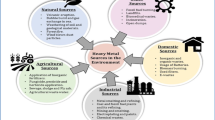Abstract
Soil column leaching experiments were conducted to assess the retention of nutrients and heavy metals in two types of mangrove soils receiving strong wastewater throughout a period of 5 months. NH4 +-N was the dominant form of nitrogen, nitrite and nitrate were in relatively low concentrations in all leachate collected. The concentrations of NH4 +-N in leachate collected from columns packed with Sai Keng of Hong Kong mangrove soil were higher than those packed with soils collected from Shenzhen of China. The leachate NH4 +-N contents of Shenzhen columns were significantly lower than that of the synthetic wastewater even at the end of the experimental period, indicating Shenzhen soils had very high capacity to bind nitrogen, and the amount of ammonium added from wastewater did not exceed the binding capacity of mangrove soil. The data also suggest that soils collected from Shenzhen mangrove swamp had higher capacity in retaining wastewater nitrogen than the Sai Keng soils. In contrast, leachate from Sai Keng columns had significantly lower ortho-P contents than those from Shenzhen columns. Actually, the leachate P concentrations of the Sai Keng columns treated with wastewater were similar to those receiving seawater (< 0.1 mg l−). This finding implies Sai Keng soils were very effective in retaining wastewater P. Throughout the experiment, most heavy metals, including Cu, Zn, Cd, Ni and Cr were not detected in all leachate samples by flame atomic absorption spectrophotometry, indicating that both types of mangrove soils were capable of trapping wastewater-borne heavy metals. The study demonstrates that mangrove soils were good traps to immobilize wastewater-borne phosphorus and heavy metals but they were less efficient in retaining nitrogen from wastewater.
Similar content being viewed by others
References
Ambus, P. & R. Lowrance, 1991. Comparison of denitrification in two Riparian soils. Soil Sci. Soc. Am. J. 55: 994–918.
APHA, AWWA & WPCF (American Public Health Association, American Water Works Association & Water Pollution Control Federation), 1989. Standard Methods for the Examination of Water and Wastewater (17th ed.). American Public Health Association, Washington, D.C.
Banus, M. D., I. Valiela & J. M. Teal, 1975. Lead, zinc and cadmium budgets in experimentally enriched salt marsh ecosystems. Est. Coast. Mar. Sci. 3: 421–430.
Boto, K. G. & W. H. Jr. Patrick, 1978. Role of wetland in the removal of suspended sediments. In P. E. Greeson & J. R. Clarks (eds.), Wetland Functions and Values: The State of Our Understanding. American Water Resources Association: 479–489.
Burgoon, P. S., T. A. DeBusk, K. R. Reddy & B. Koopman, 1990. Vegetated submerged beds with artificial substrate. I. BOD removal. J. Environ. Eng. 117(4): 394–407.
Chan E., T. A. Bursztynsky, N. Hantzsche & Y. J. Litwin, 1982. The Use of Wetland for Water Pollution Control. Municipal Environmental Research Laboratory, U.S. EPA-600/2-82-086.
Clough, B. F., K. G. Boto & P. M. Attiwill, 1983. Mangroves and sewage: a re-evaluation. In H. J. Teas (ed.), Biology and Ecology of Mangroves. Tasks for Vegetation Science Series Vol. 8, Dr. W. Junk Publishers, Lancaster: 151–162.
Conley, L. M., R. I. Dick & L. W. Lion, 1991. An assessment of the root zone method of wastewater treatment. Res. J. Wat. Pollut. Cont. Fed. 63(3): 239–247.
DeBustamante, I., 1990. Land application: its effectiveness in purification of urban and industrial wastewaters in La Mancha, Spain. Environ. Geol. Wat. Sci. 16(3): 179–185.
Dunbabin, J. S. & K. H. Bowmer, 1992. Potential use of constructed wetland for treatment of industrial wastewaters containing metals. The Sci. Tot. Environ. 111: 151–168.
Dwivedi, S. N. & K. G. Padmakumar, 1983. Ecology of a mangrove swamp near Juhu Beach, Bombay with reference to sewage pollution. In H. J. Teas (ed.), Biology and Ecology of Mangroves. Task for Vegetation Science Series Vol. 8, Dr W. Junk Publishers, Lancaster: 163–170.
Gambrell, R. P., Khalid, R. A. & W. H. Jr. Patrick, 1987. Capacity of a swamp forest to assimilate the TOC loading from a sugar refinery wastewater stream. J. Wat. Pollut. Cont. Fed. 59(10): 897–904.
Harbison, P., 1986. Mangrove muds — a sink and a source for trace metals. Mar. Pollut. Bullet. 17(6): 246–250.
Johnston, C. A. 1991. Sediment and nutrient retention by freshwater wetland: effects on surface water quality. Crit. Rev. Environ. Cont. 21(5&6): 491–565.
Mansell, R. S., P. J. McKenna, E. Flaig & M. Hall, 1985. Phosphate movement in columns of sandy soil from a wastewater-irrigated site. Soil Sci. 140(1): 59–68.
Murphy, J. & J. P. Riley, 1962. A modified single solution method for the determination of phosphate in natural wastes. Anal. Chem. Acta 27: 31–36.
Olsen, S. R., C. V. Cole, F. S. Watanabe & L. A. Dean, 1954. Estimation of available phosphorus in soils by extraction with sodium bicarbonate. U.S. Dept. Agric. Circ. 939: 1–19.
Patrick W. H. Jr. & R. A. Khalid, 1974. Phosphate release and sorption by soils and sediments. Effects of aerobic and anaerobic conditions. Science 186: 53–55.
Pell, N. & F. Nyberg, 1989. Infiltration of wastewater in a newly started pilot sand-filter system: I. reduction of organic matter and phosphorus. J. Environ. Qual. 18(4): 451–457.
Reed S. C., E. J. Middlebrooks & R. W. Crites, 1988. Natural Systems for Waste Management and Treatment. McGraw-Hill Book Co., New York, N.Y.
Rogers K. H., P. F. Breen & A. J. Chick, 1991. Nitrogen removal in experimental wetland treatment systems: evidence for the role of aquatic plants. J. Wat. Pollut. Cont. Fed. 63(7): 934–941.
Verhagen, F. J. M., H. Duyts & H. J. Laanbroek, 1992. Competition for ammonium between nitrifying and heterotrophic bacteria in continuously percolated soil columns. Appl. Environ. Microbiol. 58(10): 3303–3311.
Yamaguchi, T., P. Moldrup, S. Teranishi & D. E. Rolston, 1990. Denitrification in porous media during rapid, continuous leaching of synthetic wastewater at saturated water flow. J. Environ. Qual. 19(4): 676–683.
Author information
Authors and Affiliations
Rights and permissions
About this article
Cite this article
Tam, N.F.Y., Wong, Y.S. Mangrove soils as sinks for wastewater-borne pollutants. Hydrobiologia 295, 231–241 (1995). https://doi.org/10.1007/BF00029130
Issue Date:
DOI: https://doi.org/10.1007/BF00029130




